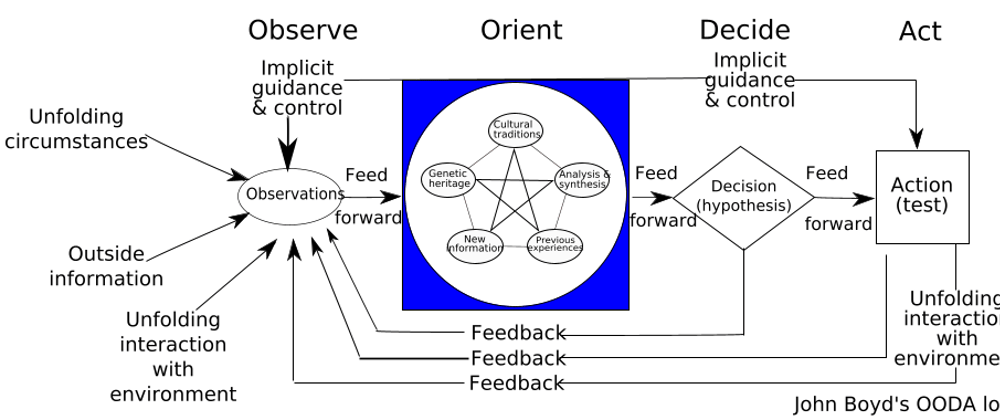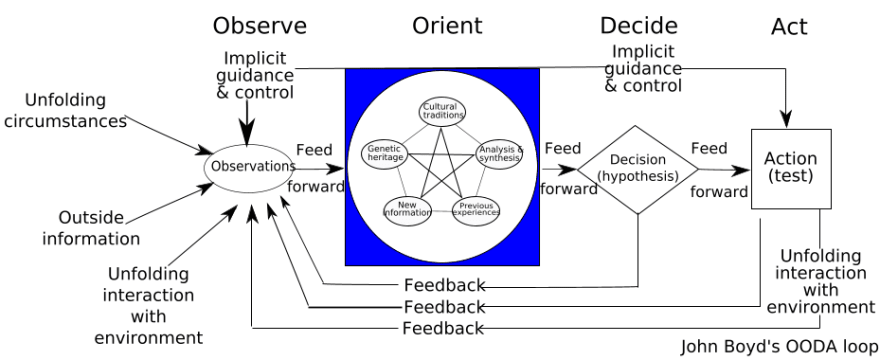If you're following my articles, you probably have a vague idea of what the OODA loop is. First, I used the term in the review of Jeff Sutherland's book on Scrum.
Sutherland was a fighter pilot and they were taught about the loop, they were trained to use it in their thinking in order to survive in the skies of Vietnam.
Then the OODA loop appeared in another book review. This time it was the biography of Colonel John Boyd, another fighter pilot who actually codified our way of thinking and the OODA loop itself.
OODA, O-O-D-A
The four letters stand for four verbs in this particular order:
- Observe
- Orient
- Decide
- Act
First, both in warfare and business, you have to observe the situation, you have to understand the big picture. Then you have to orient yourself not just in a way to understand where you are, but you have to understand what are your different options, what mental models you can apply in the given situation to achieve the output you're looking for.
With proper observation and orientation, you can (and have to) quickly decide and act. Then start the loop over.
In scrum, the result of such a loop is a working increment that helps the product owner to decide what's the next most important story to act upon, what will bring the most value to the customer.
It sounds simple, and it is.
Yet, the OODA loop is a bit more complex than that. At the same time, it is often oversimplified as I did in the above example.
Now let's have a picture of the loop from Boyd's original briefing and then go into details.
Observe
If you have a look at the above diagram, you can see that the OODA loop is more complex than a simple PDCA cycle. Especially for the phases observe and orient.
We have to understand what are the different inputs that we observe.
When you think about observation, you might simply think about the passive examination of the external world, but it's more than that.
Implicit guidance and control
Observation is not only a conscious process. Of course, you might have learned a checklist, or you might hold it in your hand and you go through the items one by one.
At the same time, observation is also working on an unconscious level.
If you are in doubt think about yourself driving to work (probably pre-Covid), you learnt the route, you barely have to think about where you are, which crossroads you just passed, which exit you'll have to take in the next roundabout. You could probably even drive to work without opening your eyes - if there was no traffic, don't ever try this!
Or just think about how you drive. Probably you don't go through the triangle you learned from your instructor
- check the left mirror
- check the right mirror
- check the internal mirror (- check speed)
All these are happening unconsciously. You have an implicit control of your environment, you have a fingertip feeling of it. Yes, that's Fingerspitzengefühl, something we discussed a few weeks earlier.
Unfolding circumstances
When you are in a rapidly changing environment, you cannot simply rely on checklists, on the learned items. You have to quickly take into account all the unfolding changes.
When you're building a new service, you cannot simply rely on past experiences and a priori knowledge. If you happen to learn on the go that a practice you used to follow has just been identified as not compliant anymore you have to take it into account.
Outside information
This is information about the opponents (enemy in a military context) gathered usually by the intelligence. In business, it could be information about competitors, or even about other teams, or simply business processes depending on the context.
Unfolding interaction with the environment
In quantum physics, changes can be even the results of observations. It's not different on a higher scale. Both in combat and in business the environment can change rapidly, even as an effect of the interaction.
These changes have to be considered during the observation phase. It might seem to be obvious, but many would take into consideration only static information, but that leads to failure and - in combat - to potential death.
Feedback, feedback, feedback
In Boyd's diagram, you can notice three feedback arrows pointing back from later phases. They all serve a similar purpose as what I just discussed. Changing data must be taken into account, and OODA is not a one time cycle but a loop, later iterations should take into account feedback originating from latter steps of previous loops.
Orient
After collecting data about the situation, we often want to make decisions too fast. We should not, we have to focus, we have to orient ourselves, we have to think about different options.
In fact, while orientation is a step that one would tend to forget, according to Boyd, orientation is the "schwerpunkt" of the OODA loop. Orientation is the focal point of the cycle.
That's where we turn data into information, that's where we generate the output needed for making a well-educated decision.
If you have a look at Boyd's original diagram, the orientation phase has five elements.
Four out of these are inputs:
- cultural traditions that can be both personal and organizational culture and they will influence how you evaluate the data you gathered.
- genetic heritage is the static part of the inputs, that's something you cannot modify but it does affect how you evaluate data
- previous experience also shapes how we process our inputs. Previous experience seems beneficial at first, but note that it might be harmful if it emphasizes negative patterns
- new information can unfold at any part of the loop and this is the last point when it can still influence the decision of the actual iteration.
After taking all the inputs, we synthesize and analyse them to generate the output. That is the only part that Boyd wrote about. His only publication, Destruction and Creation is documenting this process.
Boyd thinks that the most important thing that we can do to emerge as winners in any area of life is to get better in orientation, in fact, to always be orienting. The key to effective orientation is working with multitudes of mental models and continuously question them.
We should learn about new mental models every day, pull them apart, destruct them to understand their different parts, how the ingredients interact with each other, and then build up new patterns, new models out of the destructed elements (creation). Keep repeating these steps, understand what has worked in the past in different situations and don't stick to any model that didn't work in similar contexts.
In fact, it's better if you don't stick to any model at all, to any doctrine at all. Use them, but don't stick to them.
That's the point of never stop learning them. To understand that is no silver bullet, there is no doctrine that should be accepted without hesitation.
A doctrine, a model of yesterday can become the dogma of tomorrow and you'll end up being the man with the hammer who thinks that everything is a nail around him.
Be conscious about your orientation, try to validate the mental models you know, the mental models you studied, you created yourself. Analyze them, understand what could work in the given situation.
If you do this enough, orientation will be a fingertip feeling of yours, you'll be able to synthesize and analyze the data you gathered and make decisions like few others.
Decide
Deciding means that we chose among the action alternatives we generated in the orientation phase.
This means that we indeed have to generate multiple models while we are orienting ourselves. At the same time, we should not worry about choosing the best matching mental model because we often have imperfect information about our environment and in addition, Heisenberg's Uncertainty Principle will prevent us from making a perfect decision.
While we most know the Heisenberg Uncertainty Principle from quantum physics, it also has philosophical implications. In quantum mechanics, it says that the position and the velocity of a particle cannot both be measured exactly, at the same time, even in theory.
But Heisenberg had more in mind. In the article in which he announced the principle in 1927, he wrote that "In the strong formulation of the causal law, << If we know the present with exactitude, we can predict the future,>> it is not the conclusion, but rather the premise that is false. We cannot know, as a matter of principle, the present in all its details."
Considering that Boyd read Heisenberg article, we can understand why ruled out the possibility for a perfect decision. Just like in software development, or in engineering in general, we don't look for a perfect solution, we look for something that is good enough. We try to make our best "educated guess" about the available mental models before we'd test them.
Act
Testing our choice, our chosen mental model is also called acting and that's the last step. While in A in OODA stands for act, Boyd also called it test because he was convinced that the loop doesn't only serve as a decision-making tool, but it's also a learning system.
It's a system that helps to test our different mental models, our different hypotheses in the real world.
Acting will provide us with new information that will help us refine our models and make better decisions in the coming cycles, but it also shapes the environment so it will shape our observation.
Conclusion
Today we discussed the blueprint of human decision making that is called the OODA loop. Understanding the cycle of Observation - Orientation - Decision - Action described by Colonel John Boyd helps us understand the different factors of surviving in a rapidly changing world.
Even though what the OODA loop describes is a natural process, still learning about is essential to use it better and survive with a better chance in a fight, in a war or in a business context.
References
- OODA Loop – How To Make Better Decisions In 4 Steps
- The OODA Loop and the Half-Beat
- The Tao of Boyd: How to Master the OODA Loop
- The added value of the OODA loop to cyber security - part 2/3
Connect deeper
If you liked this article, please
- hit on the like button,
- subscribe to my newsletter
- and let's connect on Twitter!






Top comments (0)